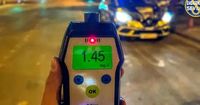At the end of 2024, the Spanish government launched a proposal aimed at reducing the permitted blood alcohol level for drivers, a significant shift toward enhancing road safety. This legislative proposal, primarily championed by the PSOE (Spanish Socialist Workers' Party), aims to effectively address the concerning rates of traffic accidents linked to alcohol consumption.
The government seeks to lower the blood alcohol limit to an unprecedented 0.10 mg/l in exhaled air and 0.2 g/l in blood. If approved, this will mark a stringent measure that intensifies the classic motto, 'If you drink, don’t drive', which the Dirección General de Tráfico (DGT) has always advocated.
Currently, Spain establishes a blood alcohol limit of 0.5 grams per liter of blood and 0.25 milligrams per liter of exhaled air. Under the new proposal, penalties for infractions related to the new limits would be considerably more severe. For instance, drivers registering between 0.1 and 0.25 mg/l in exhaled air (0.20 g/l to 0.5 g/l in blood) would face a fine of 200 euros alongside the loss of 2 points on their driving license. Should a driver exceed a reading of 0.25 mg/l up to 0.50 mg/l, the division of penalties escalates to a hefty 500 euro fine and the removal of 4 points from the license.
Most alarmingly, drivers caught with more than 0.50 mg/l in their system would incur fines reaching 1,000 euros, and they would lose 6 points from their driving license. Repeat offenders, who have already faced sanctions in the previous year for exceeding the alcohol limits, would be subject to similar hefty penalties, reinforcing the government’s zero-tolerance approach.
This proposal, currently under discussion in Spain’s Congress of Deputies, is expected to move forward with varying estimates indicating a possible enactment by summer 2025 following necessary legislative processes. As alcohol consumption is deeply ingrained in social practices across Spain, there are mounting concerns about the public's acceptance of such stringent regulations.
Statistics shed light on how alcohol affects drivers differently based on biology, and the DGT has emphasized that even minimal consumption can lead to positive readings. For example, a man weighing between 70 and 90 kilos may reach the legal limit after consuming just a third of a beer and could exceed it after two. In women weighing between 50 and 70 kilos, a single beer may be sufficient to push them past the permissible threshold due to biological differences in alcohol metabolism.
The DGT emphasizes, "The only completely safe way to drive is to consume no alcohol." This stance captures the heart of the matter, where complete abstinence remains the ultimate solution to preventing accidents. The potential for drastic consequences looms as authorities remain keenly aware of the impact of alcohol-related incidents on public health and safety.
Beyond the proposed numbers, this legislation also reflects a broader societal shift towards recognizing and combating the dangers of drinking and driving. The reduction of the legal limit aims to address not just the immediate consequences of impaired driving but also to reshape attitudes toward alcohol consumption. Public awareness campaigns are expected to coincide with these legislative measures, emphasizing responsible drinking during social gatherings.
Looking ahead, the government’s initiative underscores a growing commitment to road safety across Spain, highlighting a proactive approach in tackling the pervasive issue of alcohol impairment on the roads. The introduction of these stricter standards reflects a collective aim to mitigate risks and save lives, fostering an environment where responsible behavior is paramount.
As Spain grapples with the nuances of this proposed law, discussions are becoming increasingly relevant. Public engagement, alongside education regarding the consequences of alcohol, will be critical components in ensuring the success of this initiative, as legislators rally for greater acceptance of the zero-tolerance philosophy.
In conclusion, receiving widespread support could translate into a substantial shift in how alcohol consumption is perceived in relation to driving. As the discussions surrounding these legislative efforts continue, motorists and society at large will need to adapt to new norms aimed at preserving public safety on the roads.






